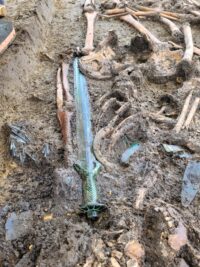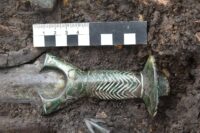incredible condition
 Archaeologists in Nördlingen, western Bavaria, have unearthed a Bronze Age sword in extraordinarily good condition. The hilt is octagonal and made entirely of bronze. It dates to the late 14th century B.C., the Middle Bronze Age, but it is in such good condition that it retains its shine.
Archaeologists in Nördlingen, western Bavaria, have unearthed a Bronze Age sword in extraordinarily good condition. The hilt is octagonal and made entirely of bronze. It dates to the late 14th century B.C., the Middle Bronze Age, but it is in such good condition that it retains its shine.
The age, shape, material and condition of the sword make it an extremely rare find, all the more so because it was discovered in its original context: an intact burial mound. Most of the mounds from this era were looted for their valuable grave goods long ago, and many of the known swords from this era were pillaged from mounds destroyed in the 19th century. Others were archaeologically excavated, but were individual finds, likely from ritual depositions.
 The sword was unearthed from a grave that held the skeletal remains of three individuals: an adult man, an adult woman and a teenager. They were buried with rich funerary furnishings, but there is as of yet no direct evidence of a familial relationship or some other connection between the three. The hilt is octagonal in shape was manufactured by casting the handle over the blade, a complex process known as overlay casting. It is intricately decorated with incised geometric designs and inlay.
The sword was unearthed from a grave that held the skeletal remains of three individuals: an adult man, an adult woman and a teenager. They were buried with rich funerary furnishings, but there is as of yet no direct evidence of a familial relationship or some other connection between the three. The hilt is octagonal in shape was manufactured by casting the handle over the blade, a complex process known as overlay casting. It is intricately decorated with incised geometric designs and inlay.
 Octagonal-hilted swords are distributed in two regions: southern Germany and northern Germany/southern Denmark. Comparisons of the casting and decoration techniques indicate that the octagonal sword found in the north consist in part of replicas of southern German originals and in part of imports. Some may have been produced by migrant smiths who brought their signature overlay casting method north.
Octagonal-hilted swords are distributed in two regions: southern Germany and northern Germany/southern Denmark. Comparisons of the casting and decoration techniques indicate that the octagonal sword found in the north consist in part of replicas of southern German originals and in part of imports. Some may have been produced by migrant smiths who brought their signature overlay casting method north.
* This article was originally published here









No comments:
Post a Comment